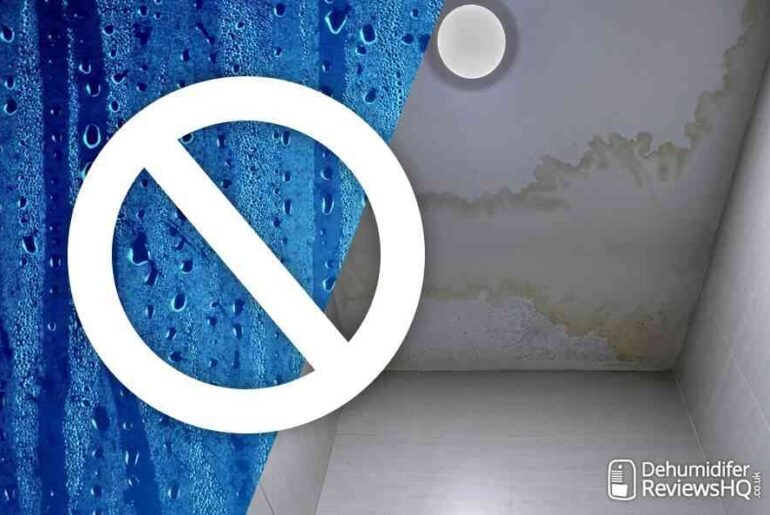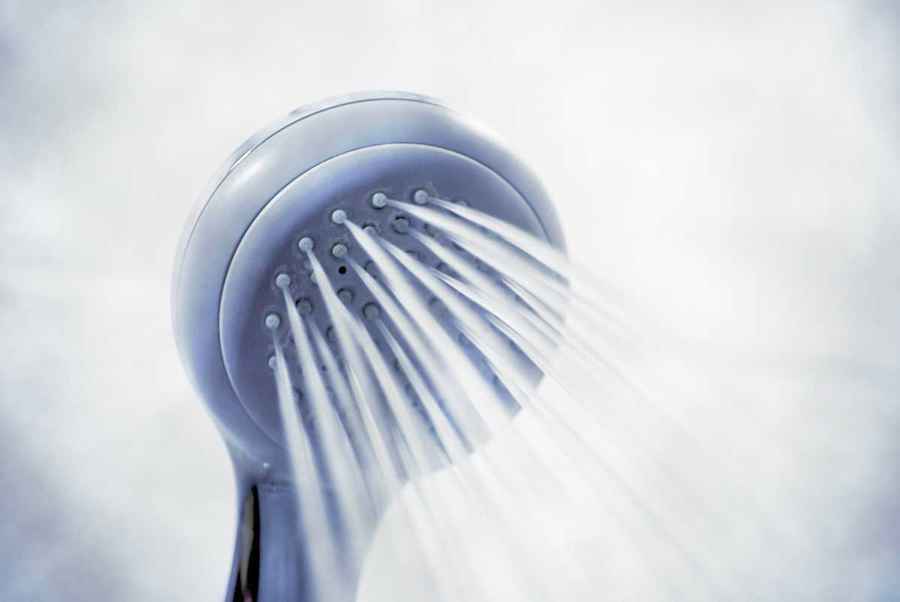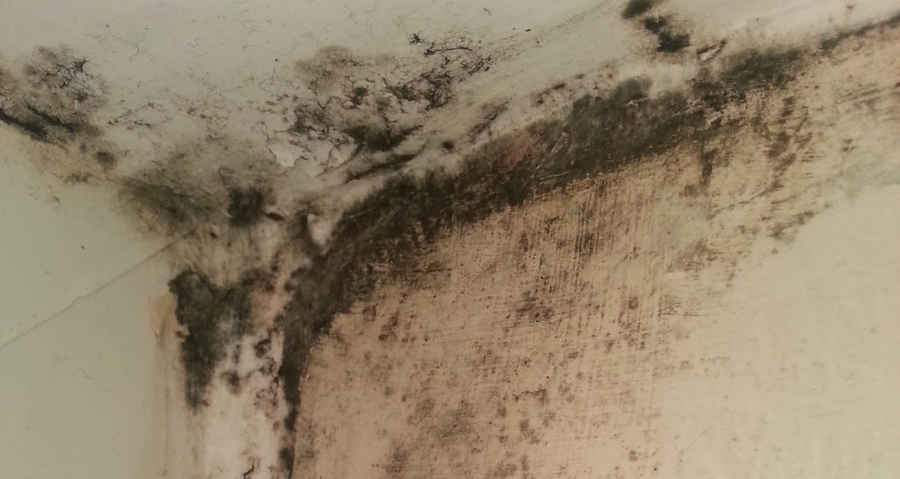Dealing with dampness on a ceiling can be a frustrating and worrying issue for homeowners and renters alike. Not only are damp ceiling patches unsightly, but they also tend to call attention to more serious underlying problems, ranging from condensation and leaks to hidden structural issues. If not addressed promptly and effectively, damp on ceiling surfaces can lead to costly repairs and pose potential health risks.
With a mission to shield you from the perils of suffering worst-case scenarios, this article strives to shed light on the causes, prevention methods, and remedies of the unfortunate plight known as ceiling dampness.
Perhaps you are in a battle of wills with this type of dampness. Maybe you only wish to fortify your knowledge against future possibilities. Whichever the case, we will arm you with all the expert insight needed to navigate the realm of damp ceilings confidently.
For those who rent their property, we will also guide you through tenancy agreements, landlord responsibilities, and tenant obligations regarding ceiling damp.
What Is Damp On A Ceiling?
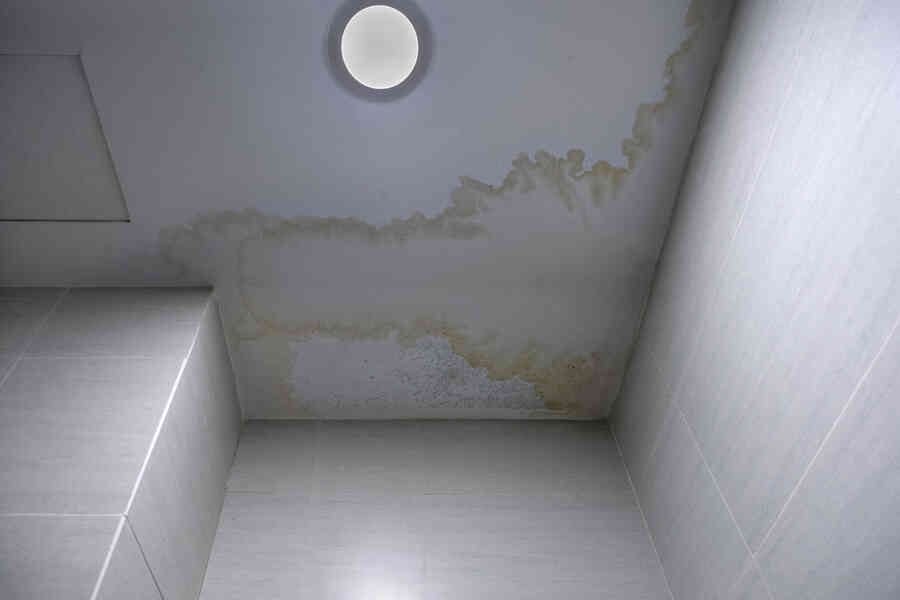
Dampness on a ceiling refers to a discoloured patch brought on by moisture infiltration or the build-up of water within a ceiling’s structure. The discolouration can present as a brown, yellow, or greyish cold spot and can vary in size from an isolated blot to a large stain spanning the ceiling’s expanse. In some cases, the wet patches can develop into mould or mildew.
1) Different Types Of Ceiling Dampness
Damp on ceilings occurs due to the presence of excess moisture. It creates the ideal breeding ground for mould or mildew, which may adversely affect your health.
So how can you identify dampness on the ceiling and take action to safeguard yourself and your loved ones? It starts with knowing how to identify the different types of ceiling dampness, which include:
- Penetrating Damp: This occurs when water enters the ceiling from external sources such as leaks from plumbing, roofs, or gutters. Penetrating damp can lead to stains, discolouration, bubbling or peeling of the ceiling paint or wallpaper.
- Rising Damp: This type of damp occurs when moisture from the ground rises through the walls and into the ceiling. Rising damp can cause plaster to fall off. It may also lead to damage to floorboards or skirting boards.
- Condensation: Condensation usually happens when warm, moist air encounters a cold surface. The moisture then forms droplets of water, which can lead to mould and mildew growth on a ceiling.
2) Identification Of Damp Ceiling
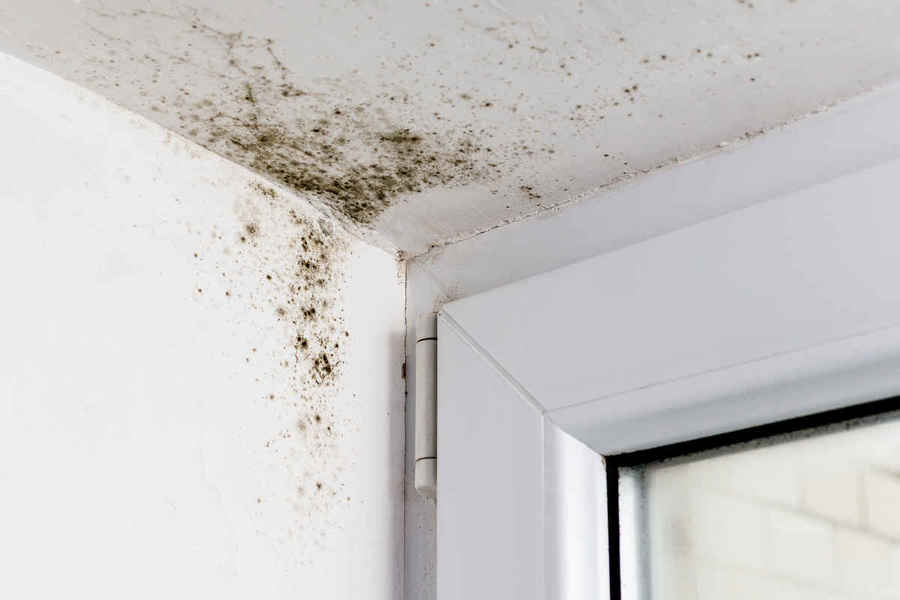 The most common signs that indicate the presence of damp on ceiling surfaces include:
The most common signs that indicate the presence of damp on ceiling surfaces include:
- Staining, discolouration, or watermarks on the ceiling
- Patches of mould or mildew
- Damp or musty smell
- Peeling paint or wallpaper
- Bowing or sagging of the ceiling
If left untreated, dampness on a ceiling can cause damage to the structural integrity of a property and lead to respiratory health problems for occupants. It is crucial to identify the source of the dampness fast and fix the issue as soon as possible to prevent further damage.
Causes Of Damp On Ceiling Surfaces
Leaking Roof
A leaking roof is the leading cause of dampness on a ceiling. As water penetrates the roofing material, it can seep through the ceiling causing unsightly watermarks, peeling paint, and dripping water in some cases.
With time, continued leaking can cause significant damage to the ceiling and surrounding structures. For instance, the weight of the water can cause the ceiling board to collapse if left unchecked for too long.
The most common cause of a leaking roof in the UK is often damaged or missing roof tiles or slate. However, other factors, such as corroded flashings, poorly maintained flat roofs, and cracked chimney flashing, can also be responsible.
Condensation
Condensation occurs when warm, moist air comes into contact with a cold surface, such as the ceiling. The moisture then condenses and forms droplets, which seep into the affected surface and cause damp patches to form. In severe cases, black mould may appear on the ceiling’s surface, presenting a hazard to health.
Ceiling dampness from condensation is more prone to areas like the bathroom and kitchen, where moisture from showers and cooking can saturate the air.
Poor ventilation is the typical cause of condensation as it traps moist air in the room. Improved ventilation can help to prevent this type of problem.
Penetrating Damp
Penetrating damp can also cause dampness on a ceiling. It occurs when water enters the building from the outside, usually through broken gutters, cracks in the walls or poorly installed pipe work. As the water enters the building, it can soak into the ceiling. The resulting damage could extend to the plaster and paintwork on your walls.
The most common causes of camp on ceilings in the UK are usually down to the age and condition of the building, with poorly maintained roofs being the primary culprits.
Rising Damp
Although a rare occurrence, rising damp can cause wetness on a ceiling. You will likely find this type of ceiling dampness in older properties or those where the damp proof course has failed or does not exist. It happens when moisture from the ground rises through the walls and all the way to the ceiling.
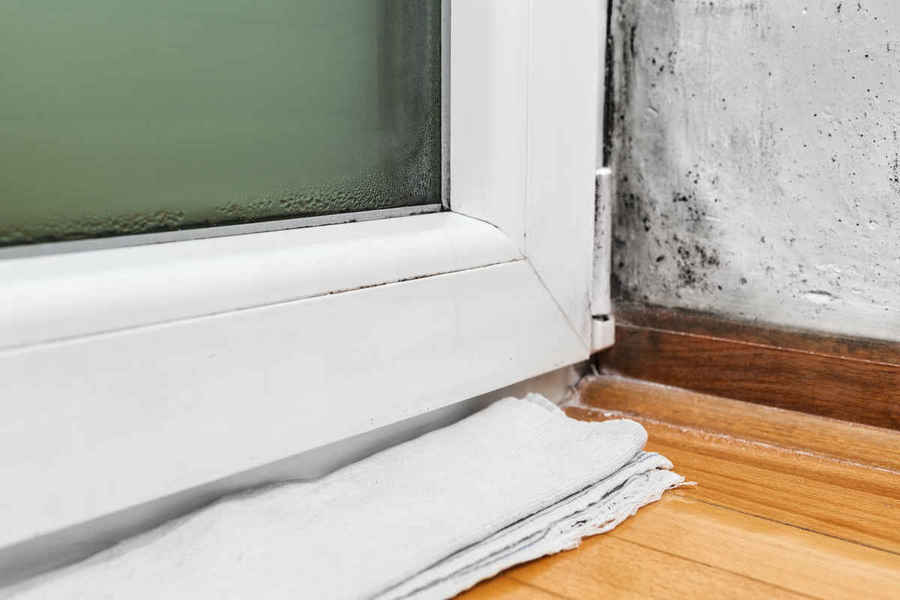 As rising damp works its way to the ceiling it can cause paint and wallpaper to blister or plaster to fall off. It can also lead to damage to walls, flooring, and skirting boards or promote the growth of mould if left unchecked.
As rising damp works its way to the ceiling it can cause paint and wallpaper to blister or plaster to fall off. It can also lead to damage to walls, flooring, and skirting boards or promote the growth of mould if left unchecked.
Most buildings have a barrier installed to prevent rising dampness. However, this barrier can become damaged over time, leading to moisture penetrating the building and causing damp problems. Landscaping and poor drainage can also cause rising damp.
How To Prevent Damp On Ceiling
1) Roof Maintenance
Since a leaking roof is the most common cause of ceiling damp, it stands to reason that regular maintenance and inspections are critical to preventing this from happening.
Roof tiles can become damaged or dislodged over time, leading to leaks. Therefore, it’s essential to watch out for any visible damage and get it repaired as soon as possible.
The recommendation is that roofs undergo inspection at least every three years. It is vital to repair any damage as soon as possible upon discovery to prevent any damage to the interior of the building.
2) Ventilation
Poor ventilation in a property can lead to a build-up of moisture, which can cause condensation and subsequent dampness on the ceiling. You can prevent this by ensuring adequate ventilation in all rooms, particularly in bathrooms and kitchens where moisture is more prevalent.
When looking to improve ventilation in a property, options abound. You can open windows regularly to allow air to circulate or have airbricks, extractor fans, and a dehumidifier installed.
3) Interior Design And Insulation
The interior design of a property can also play a part in the occurrence of dampness on a ceiling. Make it a point to avoid blocking air vents or airbricks and to ensure that furniture is not pushed up against walls, as this can prevent air from circulating correctly and cause dampness.
Insulating a property can also help prevent dampness by keeping it warm, thus reducing the risk of condensation and subsequent mould growth. You must also ensure that your choice of insulation is not only installed correctly but that it is suitable for the property type as well.
4) Waterproofing
In areas such as bathrooms and kitchens, waterproofing can be an effective way of preventing dampness on a ceiling. Waterproofing materials such as tiles, vinyl, and water-resistant paint can all help prevent moisture from penetrating walls and ceilings. It is important to note that proper installation is mandatory for waterproofing materials to prevent dampness effectively.
It is also necessary to ensure that any plumbing in a property is fitted correctly and checked regularly to prevent leaks and subsequent dampness on the ceiling.
Repairing Damp On Ceilings
Professional Help
If the damage caused by dampness on the ceiling is extensive, the best course of action is to seek professional help. A professional has the expertise to accurately identify the type and source of dampness causing the damage. This assessment will inform the recommend the appropriate steps to remedy the problem.
Basically, a surveyor or damp specialist will conduct a thorough inspection and create a detailed report outlining the type and extent of damage, the root cause of the dampness, and any other contributing factors. The professional may also be able to advice on suitable contractors for carrying out the work.
Identifying The Source Of Damp
The journey of repairing wetness on a ceiling begins with identifying the source of the problem. The source could be a leaking pipe, a damaged roof, or water penetration through a wall.
Once the exact location of the problem is confirmed, immediate repairs should follow to prevent more water from seeping in. This restoration work could involve repairing the roof, fixing a leaking pipe, or applying a sealant to stop penetration.
Removal Of Damp And Damaged Plaster
The next step is to remove any damp material and damaged plaster from the affected area. Doing this requires special care to avoid spreading spores and to prevent damage to the surrounding wall or ceiling surfaces. All materials and debris should be disposed of properly. If damage has spread over a large section of the ceiling, the best course of action will be to remove it entirely and replaster or replace it.
Installation Of A Damp Proof Course
With the damaged plaster safely removed, the next step will be installing a damp-proof course to prevent further damage. In essence, this involves the application of a special waterproof membrane between the new plaster and the wall or ceiling.
The damp proof course acts as a barrier, preventing moisture from penetrating the ceiling and causing recurrent dampness.
Repainting Or Replastering The Ceiling
The final step involves repairing the ceiling by replastering and repainting. It is essential to postpone plastering and painting a wet ceiling until after resolving the damp issue and installing a damp proof course. Also, new plaster should be allowed to dry out completely before painting.
Ordinary emulsion paint may allow moisture to penetrate again. Therefore, consider using paint suitable for damp areas.
As an extra preventative measure, you could also apply mould-resistant paint. It works well on ceilings in areas prone to high condensation exposure, such as the kitchen and bathroom.
Seeking professional help can save time and money and guarantee the permanent eradication of the dampness problem.
Dealing With Damp On Ceilings In A Rental Property
Tenancy Agreements And Obligations
As a tenant, you must understand your responsibilities and obligations regarding damp on the ceiling. Most tenancy agreements state that tenants are responsible for maintaining the property in good condition. That could entail taking reasonable steps to prevent and address problems resulting from using the property. Part of this includes reporting any signs of damp on ceiling to your landlord or letting agent as soon as possible.
Tenants should also ensure that they are not contributing to the development of dampness on the ceiling. That entails ensuring proper ventilation in all rooms, avoiding drying clothes indoors, and not blocking air vents or extractor fans. If tenants fail to fulfil their responsibilities, they may be liable for the costs of repairs.
Landlord Responsibilities
Landlords are obliged by law to provide safe and habitable properties for their tenants. It is their duty to ensure there is no damp on ceiling surfaces or other moisture-related problems like mould in rental property. Landlords must take immediate action to address reports of dampness and carry out necessary repairs promptly.
If a tenant reports dampness on the ceiling, the landlord must inspect the property to identify the source of the problem. If a fault in the structure of the building is the cause of the dampness, it is the landlord’s responsibility to carry out repairs.
However, if the situation is due to the tenant’s actions or failure to report and address the issue swiftly, the tenant may be liable for the costs of repairs. It is best practice to have a lease agreement that spells out the responsibilities of everyone involved.
Landlords must also ensure that the property has adequate ventilation and insulation to prevent dampness and mould growth. Failure to provide a habitable living environment is sufficient grounds for a tenant to take legal action against their landlord.
How Harmful Is Damp On Ceilings?
Aside from being unsightly and inconvenient, dampness on a ceiling can also pose potential health risks for occupants of the affected building. Here are some of the main risks associated with damp ceilings:
Dangers Of Mould And Mildew
One of the most significant risks stemming from dampness on a ceiling is the growth of mould and mildew. According to the UK Health and Safety Executive (HSE), exposure to mould and its spores can cause a range of health problems, including:
- Irritation of the eyes, nose, and throat
- Coughing and wheezing
- Skin irritation
- Headaches
- Fatigue
- Allergic reactions
- Asthma attacks (in people with asthma)
Health Risks Of Dampness
In addition to the risks associated with mould and mildew, there are potential health hazards related to staying in a damp environment. The NHS advises that prolonged exposure to dampness can increase the risk of several health problems, including:
- Respiratory infections
- Bronchitis
- Pneumonia
- Rhinitis
- Eczema
In some cases, exposure to damp conditions can also lead to the development of lung cancer, although this is notably a relatively rare occurrence.
Overall, it is clear that dampness on a ceiling can pose several grave risks to human health. If you suspect dampness in your home or workplace, you must take action as soon as possible to have the problem rectified.
Conclusion
Damp on a ceiling is never a pleasant sight to see. The causes may be multi-faceted, but identifying and treating dampness can prevent significant damage to the property and hazards to the occupants.
Detecting the type and source of dampness on a ceiling early on will help prevent long-term issues, such as mould and mildew. Taking steps such as regular roof inspections, efficient ventilation, and interior design considerations will go a long way in preventing ceiling dampness.
Always prioritize staying vigilant and not ignoring dampness on the ceiling. What seems like a minor issue could become significant and expensive to resolve if left unresolved. In severe cases, you might want to consider seeking professional help.
If you are a tenant and your property shows dampness on the ceiling, your sole obligation is to contact the landlord as soon as possible. Any delay on your part may affect your health and possibly cause significant damage to the property.
As a landlord, fulfil your obligations by ensuring that your tenants know how to prevent and respond when faced with dampness on their ceilings.

